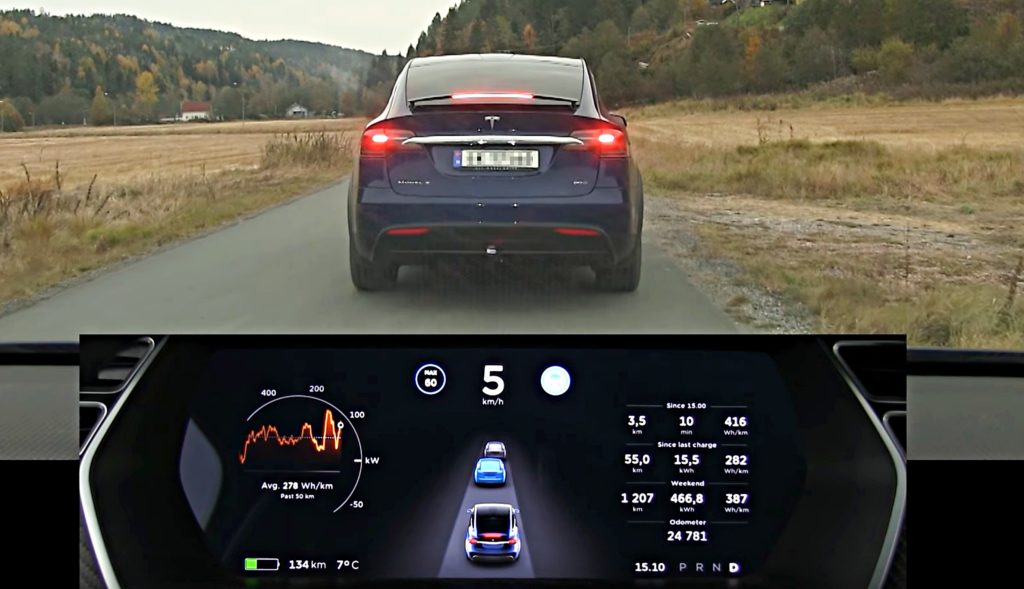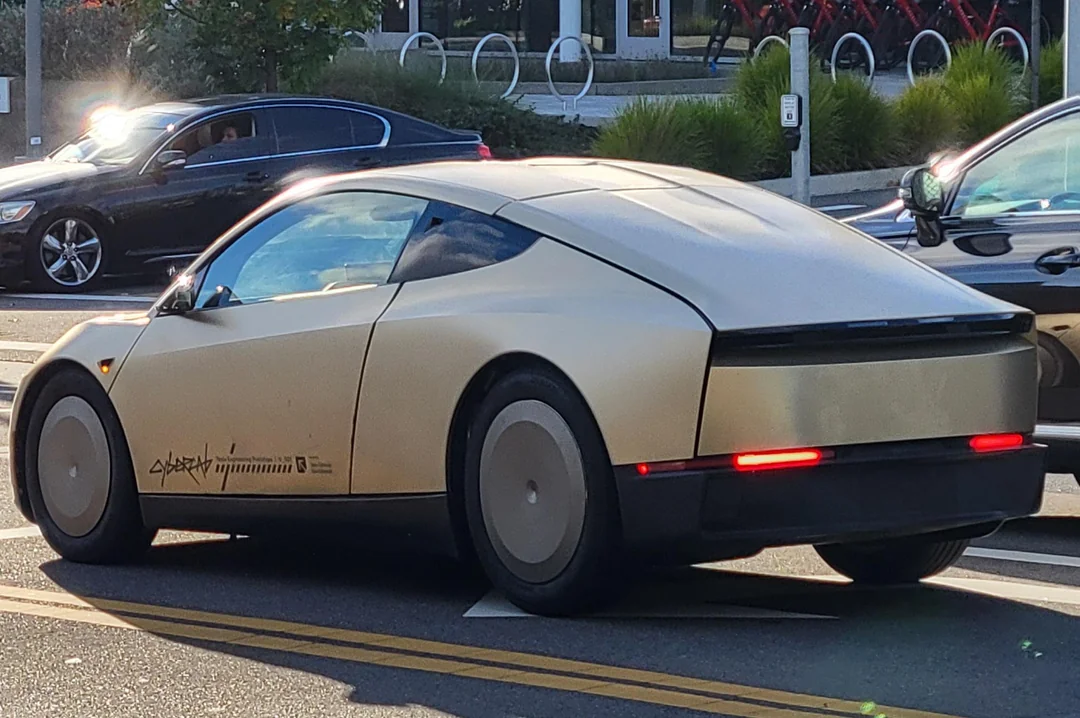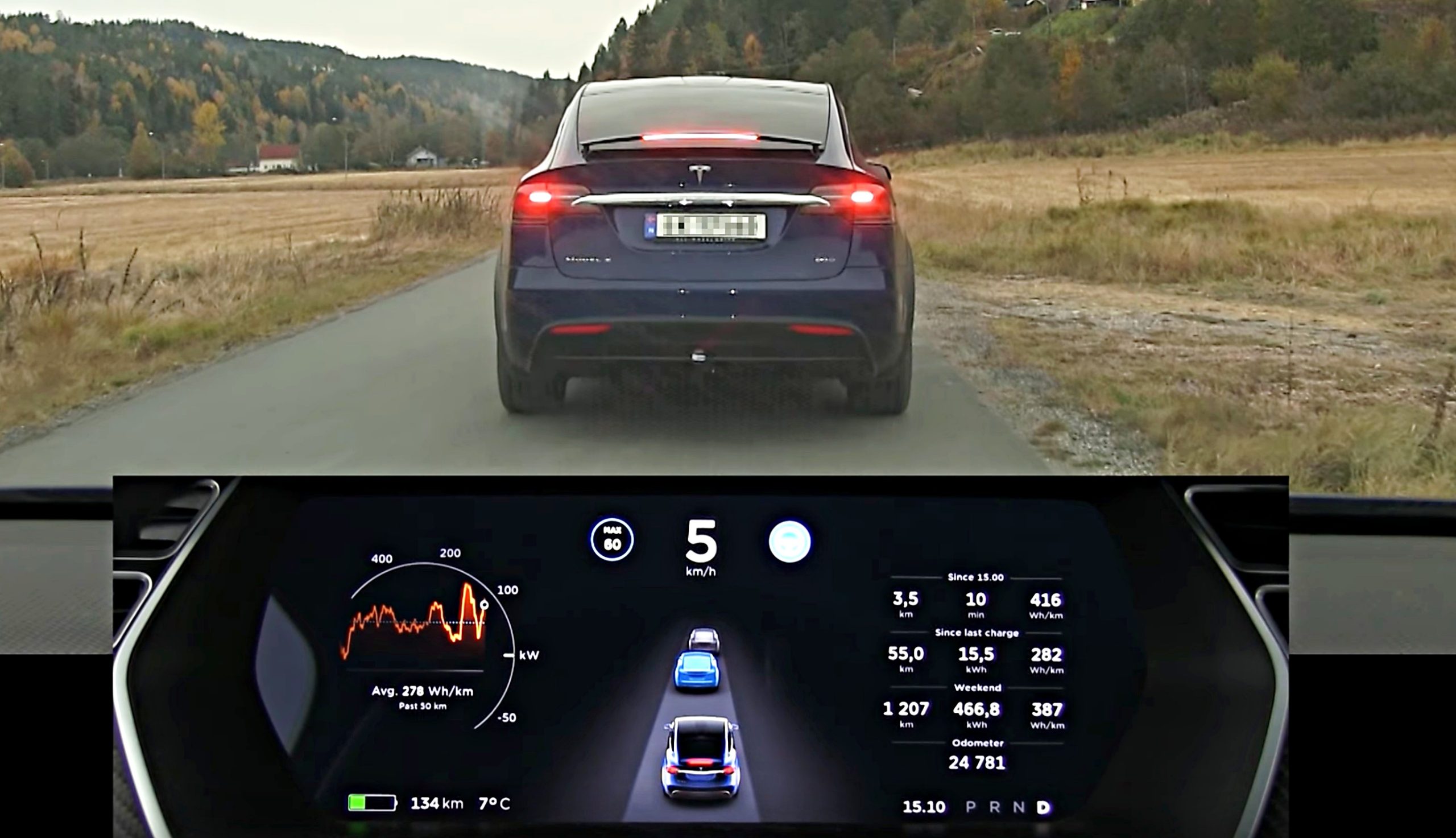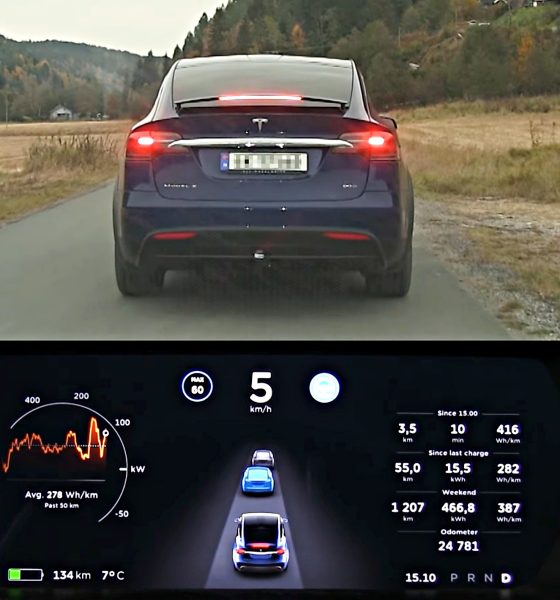In its latest report on automatic emergency braking (AEB) standards for automakers, the National Highway Traffic Safety Administration (NHTSA) and the Insurance Institute for Highway Safety (IIHS) have announced that Tesla is one of only four manufacturers so far that has reached the goal of supplying AEB on more than half of its produced vehicles in model year 2017. This first manufacturer’s report on the voluntary crash avoidance standard lists four manufacturers offering AEB on more than half and another seven with the tech on more than thirty percent of their 2017 model year vehicles.
The initiative was first announced in 2015 with a total of ten automakers on board, including Tesla. Other automakers at that time included Audi, BMW, Ford, General Motors, Mazda, Mercedes-Benz, Toyota, Volkswagen, and Volvo. A year later, an additional ten manufacturers joined. The initiative’s goal is to get manufacturer’s voluntarily on board to make forward collision warning (FCW) systems and automatic emergency braking standard equipment on all vehicles manufactured by September 1, 2022, about the time that model year 2023 vehicles would be entering production. The initiative further pushes for all trucks in the medium-duty sector (8,501 to 10,000 pounds gross vehicle weight) to meet the same standard by 2025.
Recently, manufacturers submitted their first yearly progress reports to the IIHS-NHTSA consortium for vehicles manufactured between September 1, 2016 and August 31, 2017 for the U.S. market. Tesla had the largest proportion of its vehicles including the technology for 2017, with all but only a handful of manufactured vehicles having AEB and FCW. This despite many having AEB deactivated for a portion of the year due to glitches with its sensitivity levels. The feature was reactivated in late April and early May as a software update.
For reference, the IIHS-NHTSA report states that Consumer Reports, which assists in monitoring progress towards compliance with the initiative, found that only 19 percent of 2017 model year vehicles include AEB and FCW as standard equipment. Most of those vehicles, like the Model S and Model X being reported by Tesla, are classified as luxury vehicles by price point.
The IIHS and NHTSA estimate that if the commitment by manufacturers to meet the initiative’s standards are met by 2025, a total of 28,000 crashes and 12,000 injuries will be prevented. Total commitment so far from manufacturers in the U.S. market account for over 99 percent of the vehicles sold in the country.

Tesla Model X response test for Autopilot vehicle detection [Credit: Bjørn Nyland]
Systems conforming with the vehicle standard must come with FCW that meets 2 of the 3 NHTSA 5-Star Safety Ratings’ requirements and AEB that earns at least an “Advanced” rating from the IIHS. The four complying automakers who’ve met the standard in more than fifty percent of manufactured 2017 models include Audi (73%), Mercedes-Benz (96%), and Volvo (68%) alongside Tesla (99.8%).
Other manufacturers have lower numbers, but a fast-growing commitment to the standard. Toyota at 56 percent accounts for the largest total volume of vehicles equipped to meet the initiative’s requirements with General Motors, at 20 percent, following closely behind. Lowest on the list of compliance were Fiat Chrysler, Ford, Hyundai, Kia, and Mitsubishi. Of luxury makes, only Jaguar Land Rover and Porsche don’t offer the technologies at all in 2017 model year vehicles counted.

News
Tesla Model 3 named New Zealand’s best passenger car of 2025
Tesla flipped the switch on Full Self-Driving (Supervised) in September, turning every Model 3 and Model Y into New Zealand’s most advanced production car overnight.

The refreshed Tesla Model 3 has won the DRIVEN Car Guide AA Insurance NZ Car of the Year 2025 award in the Passenger Car category, beating all traditional and electric rivals.
Judges praised the all-electric sedan’s driving dynamics, value-packed EV tech, and the game-changing addition of Full Self-Driving (Supervised) that went live in New Zealand this September.
Why the Model 3 clinched the crown
DRIVEN admitted they were late to the “Highland” party because the updated sedan arrived in New Zealand as a 2024 model, just before the new Model Y stole the headlines. Yet two things forced a re-evaluation this year.
First, experiencing the new Model Y reminded testers how many big upgrades originated in the Model 3, such as the smoother ride, quieter cabin, ventilated seats, rear touchscreen, and stalk-less minimalist interior. Second, and far more importantly, Tesla flipped the switch on Full Self-Driving (Supervised) in September, turning every Model 3 and Model Y into New Zealand’s most advanced production car overnight.
FSD changes everything for Kiwi buyers
The publication called the entry-level rear-wheel-drive version “good to drive and represents a lot of EV technology for the money,” but highlighted that FSD elevates it into another league. “Make no mistake, despite the ‘Supervised’ bit in the name that requires you to remain ready to take control, it’s autonomous and very capable in some surprisingly tricky scenarios,” the review stated.
At NZ$11,400, FSD is far from cheap, but Tesla also offers FSD (Supervised) on a $159 monthly subscription, making the tech accessible without the full upfront investment. That’s a game-changer, as it allows users to access the company’s most advanced system without forking over a huge amount of money.
News
Tesla starts rolling out FSD V14.2.1 to AI4 vehicles including Cybertruck
FSD V14.2.1 was released just about a week after the initial FSD V14.2 update was rolled out.

It appears that the Tesla AI team burned the midnight oil, allowing them to release FSD V14.2.1 on Thanksgiving. The update has been reported by Tesla owners with AI4 vehicles, as well as Cybertruck owners.
For the Tesla AI team, at least, it appears that work really does not stop.
FSD V14.2.1
Initial posts about FSD V14.2.1 were shared by Tesla owners on social media platform X. As per the Tesla owners, V14.2.1 appears to be a point update that’s designed to polish the features and capacities that have been available in FSD V14. A look at the release notes for FSD V14.2.1, however, shows that an extra line has been added.
“Camera visibility can lead to increased attention monitoring sensitivity.”
Whether this could lead to more drivers being alerted to pay attention to the roads more remains to be seen. This would likely become evident as soon as the first batch of videos from Tesla owners who received V14.21 start sharing their first drive impressions of the update. Despite the update being released on Thanksgiving, it would not be surprising if first impressions videos of FSD V14.2.1 are shared today, just the same.
Rapid FSD releases
What is rather interesting and impressive is the fact that FSD V14.2.1 was released just about a week after the initial FSD V14.2 update was rolled out. This bodes well for Tesla’s FSD users, especially since CEO Elon Musk has stated in the past that the V14.2 series will be for “widespread use.”
FSD V14 has so far received numerous positive reviews from Tesla owners, with numerous drivers noting that the system now drives better than most human drivers because it is cautious, confident, and considerate at the same time. The only question now, really, is if the V14.2 series does make it to the company’s wide FSD fleet, which is still populated by numerous HW3 vehicles.
News
Waymo rider data hints that Tesla’s Cybercab strategy might be the smartest, after all
These observations all but validate Tesla’s controversial two-seat Cybercab strategy, which has caught a lot of criticism since it was unveiled last year.

Toyota Connected Europe designer Karim Dia Toubajie has highlighted a particular trend that became evident in Waymo’s Q3 2025 occupancy stats. As it turned out, 90% of the trips taken by the driverless taxis carried two or fewer passengers.
These observations all but validate Tesla’s controversial two-seat Cybercab strategy, which has caught a lot of criticism since it was unveiled last year.
Toyota designer observes a trend
Karim Dia Toubajie, Lead Product Designer (Sustainable Mobility) at Toyota Connected Europe, analyzed Waymo’s latest California Public Utilities Commission filings and posted the results on LinkedIn this week.
“90% of robotaxi trips have 2 or less passengers, so why are we using 5-seater vehicles?” Toubajie asked. He continued: “90% of trips have 2 or less people, 75% of trips have 1 or less people.” He accompanied his comments with a graphic showing Waymo’s occupancy rates, which showed 71% of trips having one passenger, 15% of trips having two passengers, 6% of trips having three passengers, 5% of trips having zero passengers, and only 3% of trips having four passengers.
The data excludes operational trips like depot runs or charging, though Toubajie pointed out that most of the time, Waymo’s massive self-driving taxis are really just transporting 1 or 2 people, at times even no passengers at all. “This means that most of the time, the vehicle being used significantly outweighs the needs of the trip,” the Toyota designer wrote in his post.
Cybercab suddenly looks perfectly sized
Toubajie gave a nod to Tesla’s approach. “The Tesla Cybercab announced in 2024, is a 2-seater robotaxi with a 50kWh battery but I still believe this is on the larger side of what’s required for most trips,” he wrote.
With Waymo’s own numbers now proving 90% of demand fits two seats or fewer, the wheel-less, lidar-free Cybercab now looks like the smartest play in the room. The Cybercab is designed to be easy to produce, with CEO Elon Musk commenting that its product line would resemble a consumer electronics factory more than an automotive plant. This means that the Cybercab could saturate the roads quickly once it is deployed.
While the Cybercab will likely take the lion’s share of Tesla’s ride-hailing passengers, the Model 3 sedan and Model Y crossover would be perfect for the remaining 9% of riders who require larger vehicles. This should be easy to implement for Tesla, as the Model Y and Model 3 are both mass-market vehicles.











